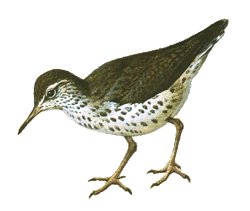Sandpipers & Plovers

The Spotted Sandpiper Actitis macularia is the most common member of a large family of long-legged shorebirds.
They are commonly seen teetering about on beaches and salt marshes, although they may also be found in disused parking lots and other places. The breast is spotted only during the breeding season; in winter it is plain white.
Plovers are similar.

